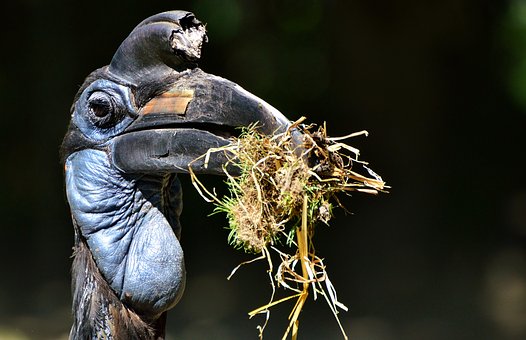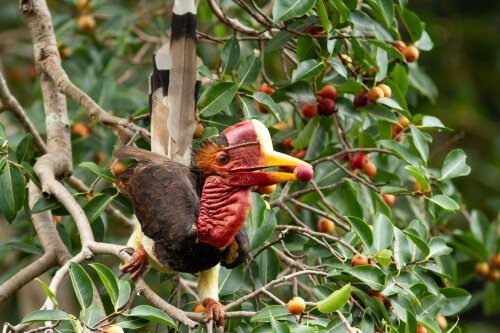Hull hornbill: reproduction and characteristics
The Buderotidae family, commonly known as the hornbill, includes about 55 living species . These birds are distributed throughout Asia, Malaysia and tropical and subtropical Africa.
They usually present a plumage of black, gray or brown with some white details in their tails. Its dark tones are compensated with bright tones at the peak or with patches of colored skin on the face and part of the neck.
In this type of bird, the size varies considerably depending on the species. For example, the black toco measures approximately 30 centimeters and weighs about 102 grams, while the southern terrestrial hornbill can measure 1.2 meters and weigh 6 kilograms. Generally, males are larger than females, but this changes according to the species.
They have a huge, flattened and curved beak, with jagged edges and bony "hulls" on the upper jaw. They use their beak as an instrument that helps them in the fight, grooming, construction of the nest and capture of prey.
Mating and reproduction of the helmet horn
Hornbills are usually monogamous couples . At the moment of courtship, the male and the female chase each other, beat their beaks and sing. Before mating, the male offers the female a food gift as a gesture of their loyalty. This gift can be an insect or a fruit.
Nesting sites can be holes or cracks in trees or rocks . Normally, these holes are natural. However, some species can nest in the abandoned nests of woodpeckers and bearded birds.

Once the female is ready to lay her eggs, she locks herself in the nest leaving a very narrow opening . This door is constructed with mud, excrement and food brought and regurgitated by the male.
Thus, the males use this opening to feed the female and the chicks. This dynamic continues until they grow too much and the mother breaks the wall of the nest. At this time, both parents are responsible for feeding the chicks until they are ready to leave the nest .
The size of the laying of the hornbills varies depending on the species . Larger species lay around one or two eggs, but the smallest can reach up to eight eggs . Throughout this incubation period the female experiences a molt of most of the feathers of its tail and wings.
The ground hornbill is the only species that does not use the same method of breeding than the other species of hornbills. It does not seal the entrance and, in general, it nests in the vegetable holes. The female and the male of the ground hornbills take turns to incubate and care for the chicks equally.
Conservation of the hornbill
The state of conservation of the hornbills is classified as vulnerable. Many of the species are threatened by illegal hunters, who look for their bright feathers. In addition, the hornbills have suffered a significant loss of their habitats.

For these reasons, several organizations are generating a movement for the conservation of these birds .These places are visited by many people passionate about birds.
Another notable conservation program is the Hornbill Adopt-A-Nest , developed by the Hornbill Research Foundation in Thailand. This program consists, mainly, of employing local people as guardians of nests.
Thus, the number of people who stole and sold chicks has decreased. This initiative protects tropical forests of illegal logging. In addition, employees are being trained to collect vital data for future research.


